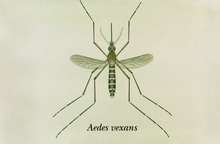Aedes vexans
| Aedes vexans | |
|---|---|
 | |
| Scientific classification | |
| Kingdom: | Animalia |
| Clade: | Euarthropoda |
| Class: | Insecta |
| Order: | Diptera |
| Family: | Culicidae |
| Genus: | Aedes |
| Species: | A. vexans |
| Binomial name | |
| Aedes vexans (Meigen), 1830 | |
Aedes vexans, the inland floodwater mosquito, or tomguito is a cosmopolitan and common pest mosquito.
Description
The adult female has a bandless proboscis, short brown scales on the scutum, and 'B' shaped (when viewed from the side) markings on each abdominal tergite. Only the female takes blood meals, preferring humans and cattle. Males feed on nectar, honeydew, and sap, on which females will also feed, although rarely. They are usually found in association with grassy pools, partially shaded woodland pools, roadside ditches, and cultivated fields.[1]
Lifecycle
After taking a blood meal, the female lays her eggs in areas that readily flood, where they hatch when inundated. Larvae are found from April through September and adults from May through October in their central range.[1]
Medical importance
Aedes vexans is a known vector of Dirofilaria immitis (dog heartworm); myxomatosis (a deadly rabbit viral disease); and Tahyna virus, a seldom-diagnosed Bunyaviridae which affects humans in Europe, causing a fever which disappears after two days, but afterward can cause encephalitis or meningitis. Aedes vexans is the most common mosquito in Europe, often comprising more than 80% the European mosquito community. Its abundance depends upon availability of floodwater pools. In summer, up to 8,000 mosquitoes can be collected per trap per night.[2] Aedes vexans exhibited significantly higher transmission rates of Zika virus than Aedes aegypti, and its wide geographic distribution, periodic extreme abundance, and aggressive human biting behavior increase its potential to serve as a Zika virus vector in northern latitudes outside the range of the primary vectors Aedes aegypti and Aedes albopictus.[3]
References
- 1 2 "Species Aedes vexans - Inland Floodwater Mosquito". BugGuide.
- ↑ "Mosquito of the Month: Aedes vexans - the Inland Floodwater Mosquito". Vector Disease Control International. Retrieved 1 February 2017.
- ↑ Kyle L. O’Donnell, Mckenzie A. Bixby, Kelsey J. Morin, David S. Bradley, and Jefferson A. Vaughan. 2017. Potential of a Northern Population of Aedes vexans (Diptera: Culicidae) to Transmit Zika Virus. Journal of Medical Entomology, 2017, 1–6; doi: 10.1093/jme/tjx087.
External links
- New Jersey Mosquito Homepage, Characteristics, Bionomics, Medical Importance
- Walter Reed Biosystematics Unit Characteristics, Bionomics, Medical Importance
- GeoSpecies Database University of Wisconsin, Photos